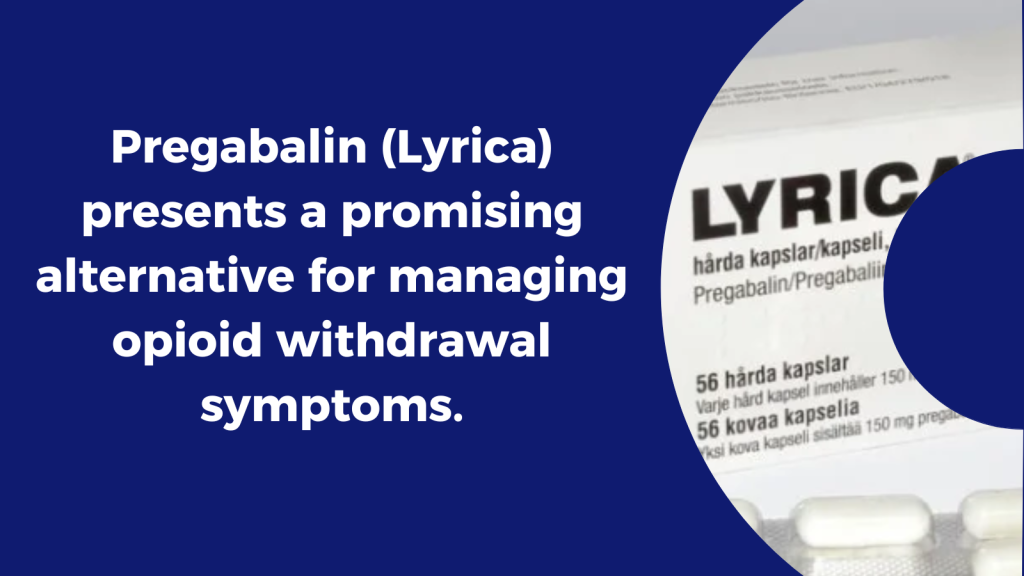As someone who has battled and overcome heroin addiction, I understand firsthand the grueling experience of opioid withdrawal. The reason I’m writing this is to share something I wish I had known during my own struggle: pregabalin, also known as Lyrica, can significantly alleviate opiate withdrawal symptoms. After extensive research and speaking with others who have used pregabalin, I found it to be remarkably effective—almost a 100% relief. This revelation could be life-changing for those in the throes of withdrawal.
My Personal Journey
Going through withdrawal is like walking through a storm without an umbrella. The pain, the cravings, the sheer helplessness—it’s a battle on multiple fronts. When I decided to quit heroin, I was desperate for anything that could make the process bearable. Back then, I stopped cold turkey, relying solely on my determination and sheer willpower, which made the journey excruciatingly difficult. You can read more about my personal experience with opioid withdrawal and my journey to healing here.
Recently, I discovered pregabalin while reading up on various treatments for opiate withdrawal. I stumbled upon several research papers and personal testimonies praising its effectiveness. This piqued my curiosity, leading me to dive deeper into the topic. I reached out to several people who had used pregabalin during their withdrawal phase. Nearly all of them had positive reviews, sharing how they managed to go about their day almost as if they weren't in withdrawal at all.
Discovering Pregabalin: A Game-Changer
One of the most striking revelations from my research was how pregabalin stood out as an effective aid for managing withdrawal symptoms. Unlike traditional methods that rely heavily on other opioids or gradual tapering, pregabalin offers a different approach. It targets the symptoms directly, providing relief from the intense discomfort that typically accompanies withdrawal.
How I Learned About Pregabalin
In my quest to find better solutions for managing withdrawal, I came across numerous forums and research articles that highlighted pregabalin’s potential. Many users shared their success stories, emphasizing how pregabalin helped them maintain a semblance of normalcy during their withdrawal period. Their experiences resonated with me, prompting further investigation into how this drug works.
Research Insights
A study involving 27 patients addicted to opiates was conducted in two phases. The first phase was a double-blind, placebo-controlled study with 900 mg/day of gabapentin, followed by a 3-week open-label study with 1600 mg/day. Participants met the DSM-IV-TR criteria for opioid dependency.
Study Design and Participants
The study design was robust, involving 27 patients who were addicted to opiates. It was conducted in two phases: an initial double-blind, placebo-controlled study with 900 mg/day of gabapentin, followed by a 3-week open-label study with 1600 mg/day. Participants met the DSM-IV-TR criteria for opioid dependency, ensuring a standardized approach to diagnosing and treating the condition.
Intervention and Measurements
Subjects received 1600 mg/day of gabapentin in addition to methadone-assisted detoxification for three weeks. The severity of withdrawal symptoms was measured using the Subjective Opiate Withdrawal Scale (SOWS) at six time points during the study. This comprehensive measurement allowed for a detailed understanding of how gabapentin affected withdrawal symptoms over time.
Findings
The findings were significant. The total SOWS score decreased markedly with the 1600 mg/day dosage of gabapentin. Compared to the previous trial with 900 mg/day, the higher dose was significantly more effective in reducing symptoms such as coldness, diarrhea, dysphoria, yawning, and muscle tension. Gabapentin at 1600 mg/day was found to be superior to both the lower dose and placebo in alleviating withdrawal symptoms.
Conclusion
Gabapentin at a dose of 1600 mg/day is effective in reducing withdrawal symptoms in patients undergoing methadone-assisted detoxification. The higher dose (1600 mg/day) was found to be superior to both the lower dose (900 mg/day) and placebo in alleviating withdrawal symptoms.
Limitations and Future Research
The study was not fully blinded, and patient compliance was checked only through interviews without laboratory assessments. The sample size was small, and further research is needed with larger sample sizes and longer follow-up periods to confirm these findings. Nonetheless, the study highlights gabapentin as a promising adjunctive treatment to improve the detoxification process for opioid-dependent patients by alleviating withdrawal symptoms more effectively at higher doses.
Technical Details About Opioids and Pregabalin
Let’s dive into some technical details about opioids and pregabalin to understand why pregabalin can be an effective alternative for managing opioid withdrawal symptoms.
Some Common Things About Pregabalin
Pregabalin is classified as an anticonvulsant or antiepileptic drug. It’s not an opioid, which means it doesn’t interact with opioid receptors in the brain. Instead, pregabalin works by modulating calcium channels in the nervous system, decreasing neurotransmitter release, and affecting signals related to pain and anxiety without the opioid-related risk of dependency and addiction.
Despite its non-opioid classification, pregabalin can be misused, particularly among those with a history of substance abuse. For instance, the prevalence of gabapentin (a drug similar to pregabalin) misuse in the general population is reported to be 1%, but it escalates dramatically among those with prescriptions (40–65%) and between 15–22% within opioid-abusing populations. These statistics highlight the need for vigilance in prescribing and monitoring pregabalin use.
Opioids bind to specific receptors in the brain, spinal cord, and other organs, effectively blocking pain signals and sometimes leading to feelings of euphoria. This interaction provides pain relief but also results in the risk of addiction and dependency. Opioids act by binding to the mu-opioid receptors in the brain, which are part of the brain’s reward system. This binding not only blocks pain signals but also releases large amounts of dopamine, a neurotransmitter associated with pleasure and reward. This dopamine release is what causes the euphoric high that can lead to addiction.
Why We Go Through Withdrawal When Opioids Stop
When opioid use stops, the brain struggles to function normally without the drug. This results in withdrawal symptoms such as anxiety, muscle aches, sweating, and nausea, as the body tries to regain its balance. Withdrawal occurs because the brain and body have become dependent on the presence of opioids to function normally. When the drugs are suddenly removed, the body’s systems are thrown into a state of chaos, leading to a range of uncomfortable and often painful symptoms. The severity of withdrawal symptoms can vary depending on the length and severity of opioid use.
Pregabalin modulates calcium channels in the central nervous system, specifically targeting the alpha2-delta site. This modulation reduces the release of several neurotransmitters involved in the transmission of pain and anxiety, providing relief without interacting with opioid receptors. By affecting the way calcium moves in and out of nerve cells, pregabalin helps to stabilize electrical activity in the brain, which can reduce the sensations of pain and anxiety associated with withdrawal.
Why Pregabalin Stops Opioid Withdrawal Symptoms
Pregabalin's ability to modulate calcium channels helps reduce the overactivity of certain neurotransmitters that occur during opioid withdrawal. This helps alleviate symptoms such as anxiety, muscle pain, and insomnia, making the withdrawal process more manageable. Pregabalin's effects on calcium channels can help calm the nervous system, reducing the hyperactivity that contributes to withdrawal symptoms. This can make the withdrawal process less severe and more bearable for individuals trying to quit opioids.
Why Pregabalin is a Better Alternative for Opioid Withdrawal
Pregabalin offers several benefits over traditional opioid withdrawal treatments:
Non-Opioid Nature
As an anticonvulsant, pregabalin doesn’t carry the same risk of dependency and addiction as opioids. This makes it a safer alternative for long-term use in managing withdrawal symptoms. While opioids work by binding to specific receptors in the brain and spinal cord to block pain signals, pregabalin works by modulating calcium channels in the nervous system. This difference in mechanism reduces the risk of addiction associated with opioids.
Reduced Risk of Misuse
Although pregabalin can be misused, its potential for addiction is lower compared to opioids. However, it’s important to use it under medical supervision to minimize any risks. Pregabalin's non-opioid nature means it doesn't produce the same euphoric high as opioids, which reduces its potential for misuse and addiction. However, it’s still crucial to use pregabalin under the guidance of a healthcare professional to ensure safe and effective treatment.
Effective Symptom Management
Pregabalin has been shown to effectively manage a range of withdrawal symptoms, including anxiety, muscle pain, and insomnia. This comprehensive symptom relief can make the withdrawal process more tolerable, increasing the chances of successful detoxification. Pregabalin's ability to modulate calcium channels helps to reduce the overactivity of certain neurotransmitters that occur during opioid withdrawal. This helps alleviate symptoms such as anxiety, muscle pain, and insomnia, making the withdrawal process more manageable.
Improving Quality of Life
By alleviating the severe symptoms associated with opioid withdrawal, pregabalin can
significantly improve the quality of life for individuals going through detoxification. This can provide a stronger foundation for long-term recovery and rehabilitation. Pregabalin's ability to reduce withdrawal symptoms can help individuals feel more comfortable and less overwhelmed during the detoxification process, which can improve their overall quality of life and increase their chances of long-term recovery.
Supporting Long-Term Recovery
Effective management of withdrawal symptoms is crucial for long-term recovery. By making the detoxification process more bearable, pregabalin can support individuals in their journey towards sobriety and help them build a healthier, addiction-free life. Pregabalin's ability to reduce withdrawal symptoms can help individuals feel more comfortable and less overwhelmed during the detoxification process, which can improve their overall quality of life and increase their chances of long-term recovery.
Conclusion
Pregabalin (Lyrica) presents a promising alternative for managing opioid withdrawal symptoms. Its non-opioid nature, reduced risk of misuse, and effective symptom management make it a valuable tool for those struggling with opioid addiction. While further research is needed to fully understand its potential, pregabalin offers hope for a more bearable withdrawal process and a better quality of life for individuals in recovery.
As someone who has been through the harrowing experience of opioid withdrawal, I wish I had known about pregabalin during my own journey. If you or someone you know is struggling with opioid addiction, I encourage you to explore the potential benefits of pregabalin with a healthcare professional. Remember, recovery is possible, and there are tools available to make the journey a little easier.
Additional Resources
For more information on opioid withdrawal and recovery, consider exploring the following resources:
- National Institute on Drug Abuse (NIDA)
- Substance Abuse and Mental Health Services Administration (SAMHSA)
- American Society of Addiction Medicine (ASAM)
Join the Conversation
If you have experiences or questions about using pregabalin for opioid withdrawal, please share them in the comments below. Your insights can help others on their journey to recovery.



Thanks for sharing.. I’m going to try this.. will update this comment after 3 days.. fingers crossed 🤞
Thanks for sharing. I read many of your blog posts, cool, your blog is very good.